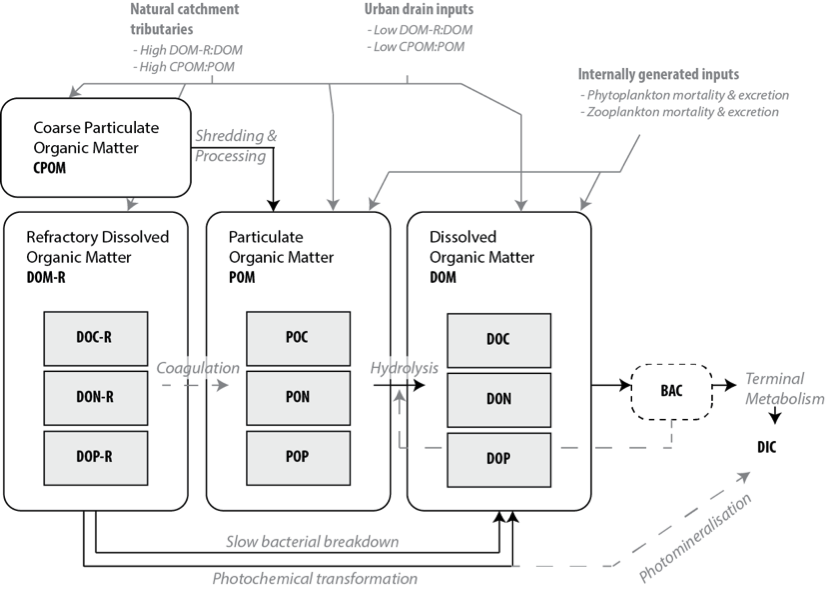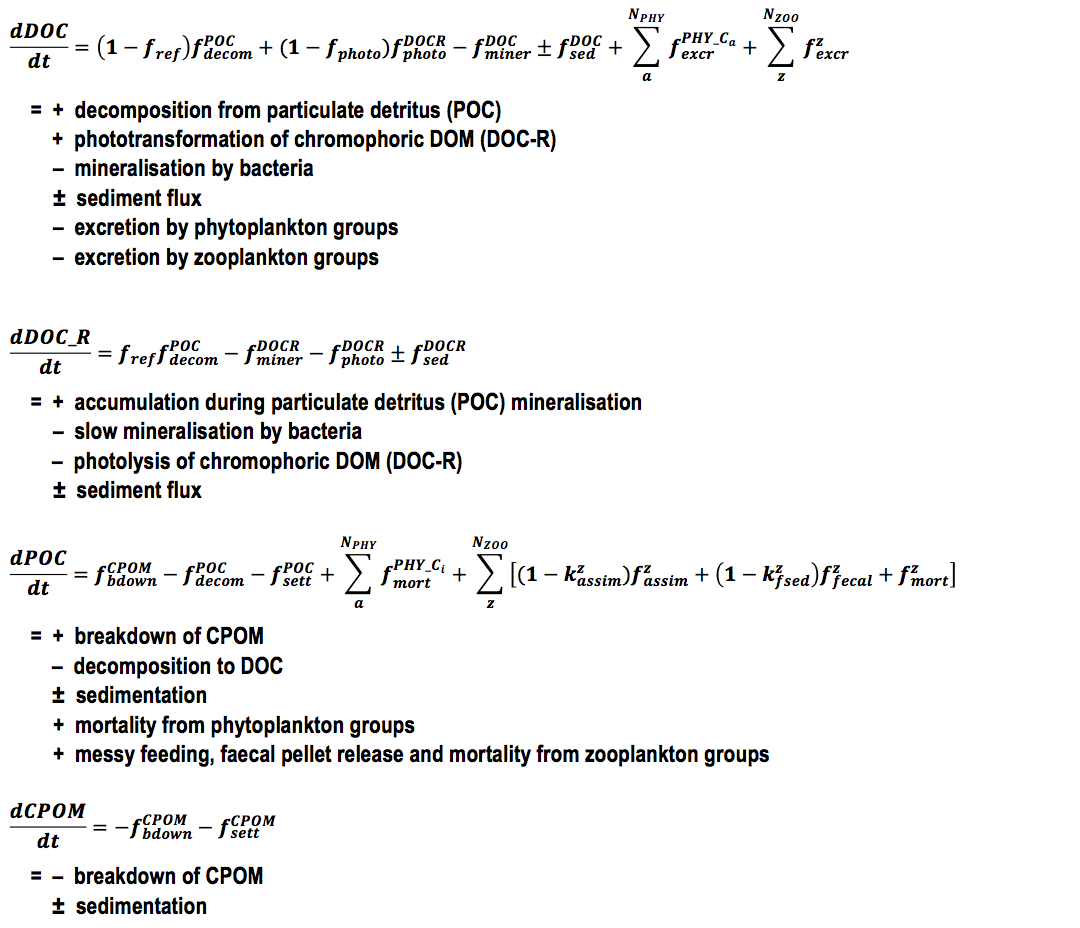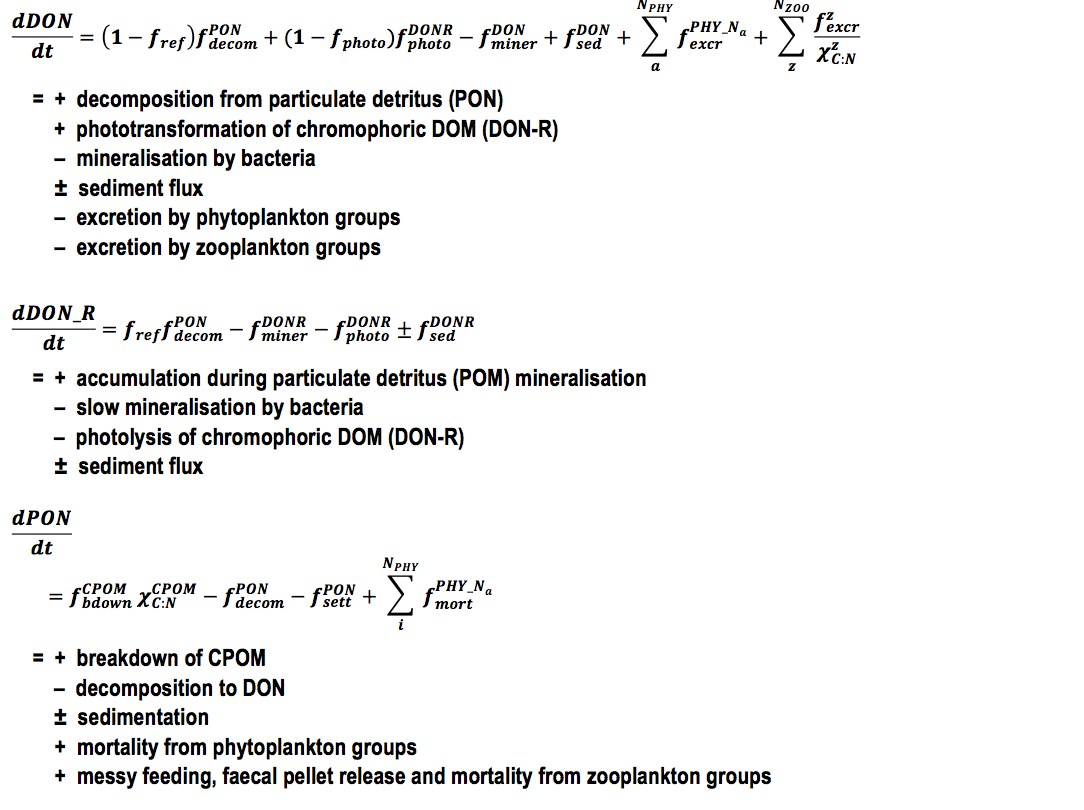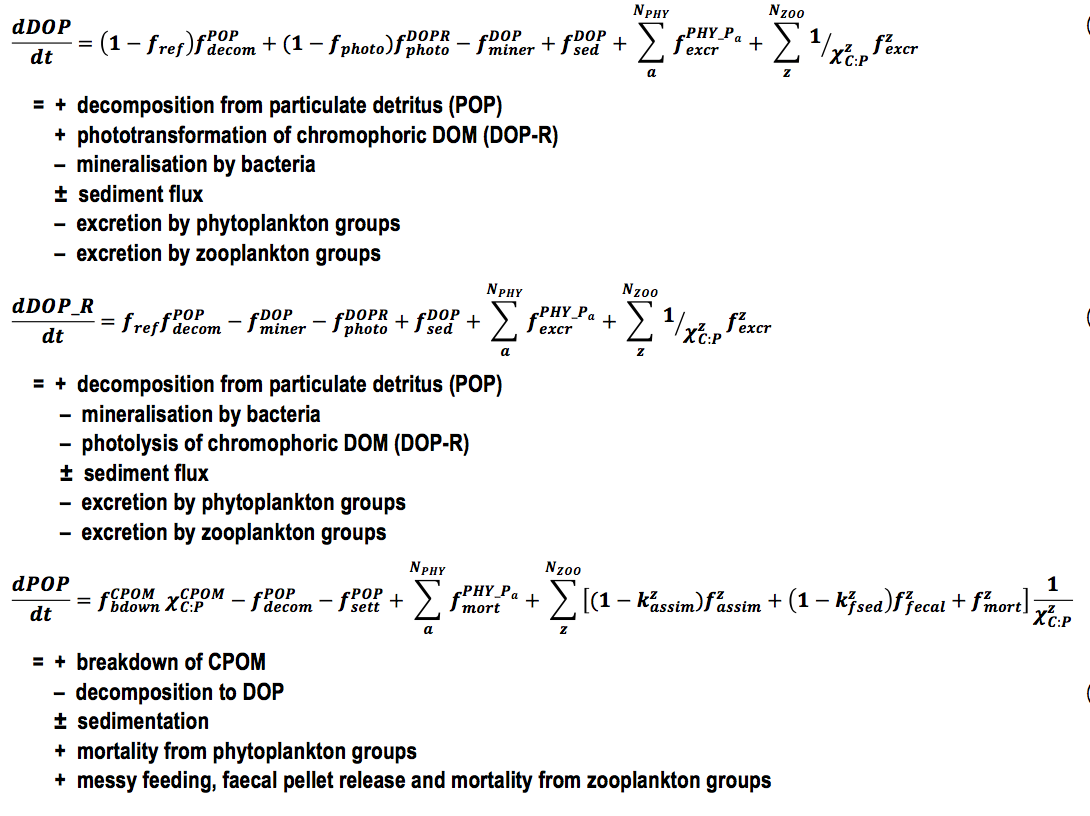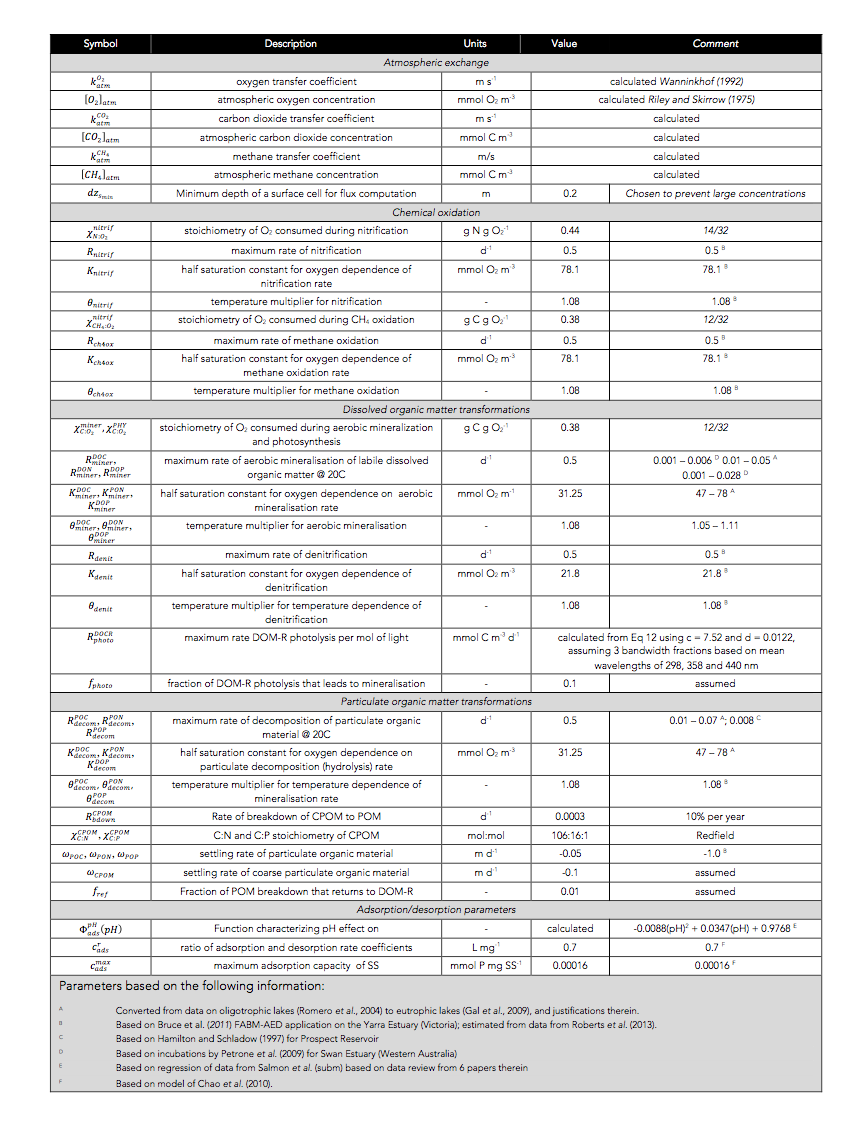Science Modules / Organic Matter
An 8-pool organic matter module is outlined in the figure below, able to capture the variable reactivity of the OM pool and its stoichiometry. Under this conceptual model the decomposition of particulate detrital material is broken down through a process of enzymatic hydrolysis that slowly converts POM to labile DOM. A small fraction, f_ref, of this material is diverted to the DOM-R pool. The bioavailable DOM material enters the bacterial terminal metabolism pathways. These are active depending on the ambient oxygen concentrations and presence of electron acceptors, and of most relevance to the SCE, these pathways aerobic breakdown, denitrification, sulfate reduction, and methanogenesis. In most model approaches it is assumed these communities vary in response to temperature, and are mediated using a simple oxygen dependence or limitation factor. Ultimately, extending the mineralization rates to be computed from thermodynamic arguments is possible and has been discussed recently by Paraska et al. (2014), with the potential for advances in this area as analytical tools for NOM characterization are applied within the SCE system. Reoxidation of reduced by-products is also included to account the role of nitrifiers, sulfate oxidising bacteria (SOB) and methane oxidising bacteria (MOB).
Figure 1: Schematic overview of organic matter (OM) pools and their interactions. Grey dashed line indicates optional process pathway. Different tributaries to the model must be prescribed OM pool boundary concentrations based on land-use specific ratios of POM and DOM reactivity.
Ultraviolet light is also known to drive photochemical breakdown of chromophoric DOM, conceptually equivalent to the DOM-R pool in Figure 2. This photolysis process can take shape either as phototransformation of complex DOM-R molecules to more bioavailable molecules (ie., DOM in Figure 2), or as photomineralisation, where by components of the DOM-R molecule are mineralised. This is modelled based on a known intensity of UV photons, which drives a stoichiometrically equivalent loss of DOM-R via the photolysis reaction, and f_(photo) is introduced as an empirically defined fraction that indicates the extent to which the process transforms the DOM-R molecules to bioavailable molecules or completely mineralises them.
Filterable reactive phosphorus also is known to adsorb onto suspended solids (SS), however, the rate is often site specific (Froelich, 1988). In particular the adsorbed fraction varies considerably within estuaries depending on the nature of the particle origin and their size distribution, and both Langmuir and Freundlich isotherm models have been demonstrated to capture the adsorption process well (Zhang et al., 2009).
Filterable reactive phosphorus also is known to adsorb onto suspended solids (SS), however, the rate is often site specific (Froelich, 1988). In particular the adsorbed fraction varies considerably within estuaries depending on the nature of the particle origin and their size distribution, and both Langmuir and Freundlich isotherm models have been demonstrated to capture the adsorption process well (Zhang et al., 2009).
The above descrioption is summarized in the equation tables in the right 'Equations' tab and in the 'Inorganic nutrient' module in the form of balance equations.
aed2_organic_matter: Mass balance and functions related to the organic matter model
---------------Dissolved and partical organic carbon --------------------
---------------Dissolved and partical organic nitrogen --------------------
---------------Dissolved and partical organic phosphorus --------------------
---------------Generic parameterization --------------------
---------------Parameters --------------------
Variable Summary & Setup Options
| Variable Name | Description | Units | Variable Type | Core/Optional |
|---|---|---|---|---|
OGM_don |
Dissolved Organic Nirtogen (DON) | $$mmol\,m^{-3}$$ | Pelagic | Core |
OGM_dop |
Dissolved Organic Phosphorus (DOP) | $$mmol\,m^{-3}$$ | Pelagic | Core |
OGM_pon |
Particulate Organic Nitrogen (PON) | $$mmol\,m^{-3}$$ | Pelagic | Core |
OGM_pop |
Particulate Organic Phorsphorus (POP) | $$mmol\,m^{-3}$$ | Pelagic | Core |
OGM_poc |
Particulate Organic Carbon (POC) | $$mmol\,m^{-3}$$ | Pelagic | Core |
OGM_doc |
Dissolved Organic Carbon (DOC) | $$mmol\,m^{-3}$$ | Pelagic | Core |
OGM_donr |
Refractory DON | $$mmol\,m^{-3}$$ | Pelagic | Optional : simRpools = .true. |
OGM_dopr |
Refractory DOP | $$mmol\,m^{-3}$$ | Pelagic | Optional : simRpools = .true. |
OGM_docr |
Refractory DOC | $$mmol\,m^{-3}$$ | Pelagic | Optional : simRpools = .true. |
OGM_cpom |
Coarse Particulate Organic Matter (CPOM) | $$mmol\,m^{-3}$$ | Pelagic | Optional : simRpools = .true. |
| Variable Name | Description | Units | Variable Type | Core/Optional |
|---|---|---|---|---|
OGM_cdom |
Chromophoric Dissolved Organic Matter | $$mmol\,m^{-3}$$ | - | - |
OGM_pon_miner |
PON mineralisation | $$mmol\,m^{-3}\,day^{-1}$$ | - | - |
OGM_don_miner |
DON mineralisation | $$mmol\,m^{-3}\,day^{-1}$$ | - | - |
OGM_sed_pon |
PON sediment flux | $$mmol\,m^{-2}\,day^{-1}$$ | - | - |
OGM_sed_don |
DON sediment flux | $$mmol\,m^{-2}\,day^{-1}$$ | - | - |
OGM_pop_miner |
POP mineralisation | $$mmol\,m^{-3}\,day^{-1}$$ | - | - |
OGM_dop_miner |
DOP mineralisation | $$mmol\,m^{-3}\,day^{-1}$$ | - | - |
OGM_sed_pop |
POP sediment flux | $$mmol\,m^{-2}\,day^{-1}$$ | - | - |
OGM_sed_dop |
DOP sediment flux | $$mmol\,m^{-2}\,day^{-1}$$ | - | - |
OGM_poc_miner |
POC mineralisation | $$mmol\,m^{-3}\,day^{-1}$$ | - | - |
OGM_doc_miner |
DOC mineralisation | $$mmol\,m^{-3}\,day^{-1}$$ | - | - |
OGM_sed_poc |
POC sediment flux | $$mmol\,m^{-2}\,day^{-1}$$ | - | - |
OGM_sed_doc |
DOC sediment flux | $$mmol\,m^{-2}\,day^{-1}$$ | - | - |
OGM_psed_poc |
POC sedimentation | $$mmol\,m^{-2}\,s^{-1}$$ | - | - |
OGM_psed_pon |
PON sedimentation | $$mmol\,m^{-2}\,s^{-1}$$ | - | - |
OGM_psed_pop |
POC sedimentation | $$mmol\,m^{-2}\,s^{-1}$$ | - | - |
| Parameter Name | Description | Units | Parameter Type | Default | Typical Range | Comment |
|---|---|---|---|---|---|---|
poc_initial |
initial POC conc | $$mmol\,m^{-3}$$ | float | 100 | - | - |
doc_initial |
initial DOC conc | $$mmol\,m^{-3}$$ | float | 100 | - | - |
pon_initial |
initial PON conc | $$mmol\,m^{-3}$$ | float | 16 | - | - |
don_initial |
initial DON conc | $$mmol\,m^{-3}$$ | float | 16 | - | - |
pop_initial |
initial POP conc | $$mmol\,m^{-3}$$ | float | 1 | - | - |
dop_initial |
initial DOP conc | $$mmol\,m^{-3}$$ | float | 1 | - | - |
docr_initial |
initial DOCR conc | $$mmol\,m^{-3}$$ | float | - | Only required if simRPools == .true. | |
donr_initial |
initial DONR conc | $$mmol\,m^{-3}$$ | float | - | Only required if simRPools == .true. | |
dopr_initial |
initial DOPR conc | $$mmol\,m^{-3}$$ | float | - | Only required if simRPools == .true. | |
cpom_initial |
initial CPOM conc | $$mmol\,m^{-3}$$ | float | - | Only required if simRPools == .true. | |
Rpoc_hydrol |
Maximum rate of decomposition of POC at 20C | $$day^{-1}$$ | float | 5e-01 | 0.01-0.08 | - |
Rdoc_minerl |
Maximum rate of aerobic mineralisation of labile DOC at 20C | $$day^{-1}$$ | float | 5e-01 | 0.01-0.08 | - |
Rpon_hydrol |
Maximum rate of decomposition of PON at 20C | $$day^{-1}$$ | float | 5e-01 | 0.01-0.08 | - |
Rdon_minerl |
Maximum rate of aerobic mineralisation of labile DON at 20C | $$day^{-1}$$ | float | 5e-01 | 0.01-0.08 | - |
Rpop_hydrol |
Maximum rate of decomposition of POP at 20C | $$day^{-1}$$ | float | 5e-01 | 0.01-0.08 | - |
Rdop_minerl |
Maximum rate of aerobic mineralisation of labile DOP at 20C | $$day^{-1}$$ | float | 5e-01 | 0.01-0.08 | - |
theta_hydrol |
temperature multiplier for temperature dependence of particulate decomposition rate | - | float | 1e+00 | 1e+00 | - |
theta_minerl |
temperature multiplier for temperature dependence of mineralisationrate | - | float | 1e+00 | 1e+00 | - |
Kpom_hydrol |
half saturation constant for oxygen dependence on particulate decomposition rate | $$mmol O2\,m^{-3}$$ | float | 3e+01 | 47-78 | - |
Kdom_minerl |
half saturation constant for oxygen dependence on aerobic mineralisation rate | $$mmol O2\,m^{-3}$$ | float | 3e+01 | 47-78 | - |
doc_miner_reactant_variable |
state variable to be linked to rate of DOC mineralisation | - | string | - | - | - |
doc_miner_product_variable |
state variable to be product of DOC mineralisation | - | string | - | - | - |
don_miner_product_variable |
state variable to be product of DON mineralisation | - | string | - | - | - |
dop_miner_product_variable |
state variable to be product of DOP mineralisation | - | string | - | - | - |
simRPools |
switch to enable refractory organic matter pools | - | boolean | .false. | - | - |
Rdocr_miner |
Maximum rate of aerobic mineralisation of labile DOCR at 20C | $$day^{-1}$$ | float | 1e-02 | - | - |
Rdonr_miner |
Maximum rate of aerobic mineralisation of labile DONR at 20C | $$day^{-1}$$ | float | 1e-02 | - | - |
Rdopr_miner |
Maximum rate of aerobic mineralisation of labile DOPR at 20C | $$day^{-1}$$ | float | 1e-02 | - | - |
Rcpom_bdown |
Maximum rate of CPOM breakdown at 20C | $$day^{-1}$$ | float | 1e-02 | - | - |
X_cpom_n |
C:N stoichiometry of CPOM | - | float | 106:16 | - | - |
X_cpom_p |
C:P stoichiometry of CPOM | - | float | 106:1 | - | - |
KeDOM |
light extinction coefficient due to DOM contribution | - | float | 1e-04 | - | - |
KePOM |
light extinction coefficient due to POM contribution | - | float | 1e-04 | - | - |
KeDOMR |
light extinction coefficient due to DOMR contribution | - | float | 1e-04 | - | - |
KeCPOM |
light extinction coefficient due to CPOM contribution | - | float | 1e-04 | 10% per year | - |
simphotolysis |
switch to enable light related organic matter processes | - | boolean | .false. | - | - |
photo_c |
quantum yield coefficient | - | float | 8e-01 | - | - |
settling |
option of settling velocity calculation method | - | integer | - | - | |
w_pom |
settling rate of POM | $$m\,day^{-1}$$ | float | - | - | |
d_pom |
diameter of POM | m | float | - | - | |
rho_pom |
POM density | $$kg\,m^{-3}$$ | float | - | - | |
w_cpom |
settling rate of POM | $$m\,day^{-1}$$ | float | - | - | |
d_cpom |
diameter of POM | m | float | - | - | |
rho_cpom |
POM density | $$kg\,m^{-3}$$ | float | - | - | |
resuspension |
switch to enable sediment resuspension calculation | - | integer | - | - | |
resus_link |
resuspension-linked variable | - | string | - | - | - |
sedimentOMfrac |
Organic matter fraction in sediment | - | float | 5e-01 | - | - |
Xsc |
C fraction in sediment OM | - | float | 5e-01 | - | - |
Xsn |
N fraction in sediment OM | - | float | 5e-02 | - | - |
Xsp |
P fraction in sediment OM | - | float | 5e-03 | - | - |
Fsed_doc |
sediment DOC flux | $$mmol\,m^{-2}\,day^{-1}$$ | float | - | - | |
Fsed_don |
sediment DON flux | $$mmol\,m^{-2}\,day^{-1}$$ | float | - | - | |
Fsed_dop |
sediment DOP flux | $$mmol\,m^{-2}\,day^{-1}$$ | float | - | - | |
Ksed_dom |
sediment DOM flux | $$mmol\,m^{-2}\,day^{-1}$$ | float | - | - | |
theta_sed_dom |
temperature multiplier for temperature dependence of sediment DOM decomposition rate | - | float | 1e+00 | - | - |
extra_diag |
switch to store net sediment fluxes as diagnostic variables | .false. | boolean | - | - |
An example nml block for the organic matter module is shown below:
&aed2_organic_matter
!-- Initial concentrations for OM variables (mmol/m3)
poc_initial = 78.5
doc_initial = 39.9
pon_initial = 8.3
don_initial = 1.3
pop_initial = 8.3
dop_initial = 1.5
docr_initial = 350.00
donr_initial = 13.0
dopr_initial = 3.0
cpom_initial = 100.00
!-- Breakdown and mineralisation (basic pool)
Rpoc_hydrol = 0.05
Rdoc_minerl = 0.001
Rpon_hydrol = 0.05
Rdon_minerl = 0.005
Rpop_hydrol = 0.05
Rdop_minerl = 0.001
theta_hydrol = 1.08
theta_minerl = 1.08
Kpom_hydrol = 31.25
Kdom_minerl = 31.25
doc_miner_reactant_variable='OXY_oxy'
doc_miner_product_variable=''
don_miner_product_variable='NIT_amm'
dop_miner_product_variable='PHS_frp'
!-- Refractory organic matter (optional)
simRPools = .false.
Rdocr_miner = 0.0001
Rdonr_miner = 0.0001
Rdopr_miner = 0.0001
Rcpom_bdown = 0.0001
X_cpom_n = 0.0005
X_cpom_p = 0.0001
!-- Light related parameters
KeDOM = 0.000005
KePOM = 0.00096
KeDOMR = 0.10000 ! = 1 (assuming KeDOMR is applied to CDOM in /m)
KeCPOM = 0.00096 ! = 0.08 (/m)/(mg/L) /83.3 (mmol/m3)/(mg/L)
simphotolysis = .false. !.true.
!photo_fmin
photo_c = 0.75
!-- Particle settling parameters
settling = 3
w_pom = -0.06
d_pom = 2e-6
rho_pom = 1.12e3
w_cpom = -0.01
d_cpom = 1e-5
rho_cpom = 1.3e3
!-- Sediment interaction parameters (basic model)
resuspension = 1
resus_link = 'TRC_resus'
sedimentOMfrac = 0.5
Xsc = 0.5
Xsn = 0.05
Xsp = 0.005
Fsed_doc = 2.0
Fsed_don = 1.0
Fsed_dop = 0.020
!Fsed_doc_variable,
!Fsed_dop_variable,
!Fsed_don_variable,
Ksed_dom = 4.5
theta_sed_dom = 1.08
!-- Other options
extra_diag = .false. !.true.
!poc_min, poc_max, doc_min, doc_max
!pon_min, pon_max, don_min, don_max
!pop_min, pop_max, dop_min, dop_max
/
Examples
Publications & References
Paraska, D.W., Hipsey, M.R., and Salmon, S.U. 2014. Sediment diagenesis models: review of approaches, challenges and opportunities. Environmental Modelling and Software 61, 297-325.
Zhang, W., et al, 2009. Evaluation of two Langmuir models for phosphorus sorption of phosphorus-enriched soils in New York for environmental applications. Soil Science 174, 523-530.
Froelich, P.N. 1988. Kinetic control of dissolved phosphate in natural rivers and estuaries: a primer on the phosphate buffer mechanism. Limnology and Oceanography 33, 649-668.
